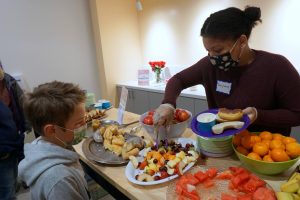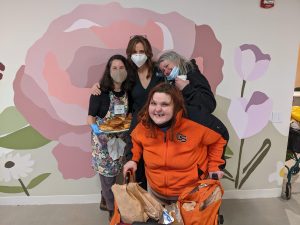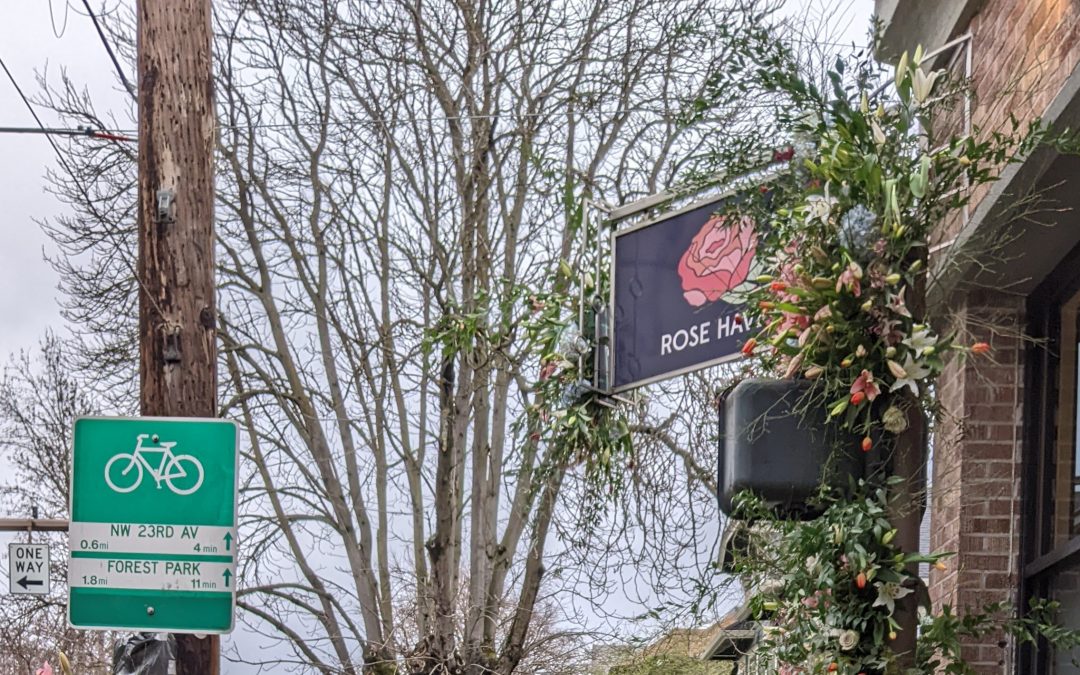
Jun 2, 2023 | Front Page, Woman Owned Business
Did you know domestic violence is the leading cause of homelessness for women? Rose Haven is a trauma-informed day shelter for women, children, and marginalized genders. Its new space opened on March 8, 2022, after nearly two years of operating from tents in the COVID era.
PDX Local interviews Liz Starke, Development Director for Rosehaven.org.
As a day shelter, what services do you offer?
Rose Haven is a safe place designed with a trauma informed lens where you can go during the hours when many overnight shelters are closed. We offer a secure mailing address, access to meals, showers, restrooms, clothing, first aid, financial assistance and one-on-one advocacy for our guests. Most importantly, we offer community and dignity to a population facing extreme stigma and isolation. Currently, Oregon has the second highest rate of literally unsheltered people in the country- that is our neighbors living outside, in cars or in tents. All of the night shelters are full with wait lists, so we play an important role by bridging the gaps in services and offering help to all those folks not lucky enough to get a shelter bed. For example, if we had 40 beds that would mean we could help 40 people, in our model we are able to serve thousands of women and children a year.
What is the story of Rose Haven? How did it get started?
Rose Haven has been an important resource for women and children experiencing trauma in Portland for 25 years. We were founded in 1997 as a program of Catholic Charities after our founding director, Sr. Cathie Boerboom conducted a survey where she walked the streets of Portland and asked women what they needed. The overwhelming response was a safe place to go during the day, where they could take their children and access resources. Twenty-five years later we are still offering programs based off of our guests’ self-defined needs; offering a low-barrier and accessible community resource center where women can meet physical and emotional needs, access social services and find community. Although not a religious organization, Rose Haven operates under the Good Shepherd value system which embodies “Compassion”, “Individual Worth”, “Reconciliation” and “Zeal”.
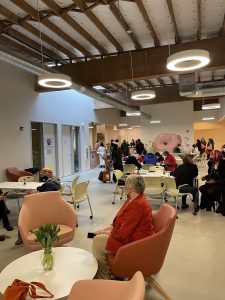
What special challenges do women and children face when they are homeless?
For women, it is especially dangerous to live outside and constantly be exposed. Women are sometimes referred to as “the hidden homeless”, because they go to great lengths to stay out of sight and not look vulnerable in order to stay safe. Domestic violence is the leading cause of homelessness for women, and unfortunately once they are outside they are even more likely to experience violence. This is why a sanctuary specifically for people marginalized by their gender is so important, because otherwise these women have to face their predators just to receive help in a co-ed space.
How have your mission and service offerings changed in the era of COVID?
COVID made our jobs really hard, but ultimately forced us to move into our dream home. Prior to the pandemic, we were functioning out of a very cozy ( some might call it cramped) church basement…where we were serving about 3,700 people a year- about 100 people a day! Needless to say we couldn’t socially distance in that space – so we had to make the really hard choice to push supply distribution to the sidewalk in order to keep our guests safe. For nearly two years we served up meals and clothing on the sidewalk, even doing first aid under a tent. Our guests only came inside to use the restroom, take a shower or meet one on one with a social worker – and for many this was their only opportunity to come indoors at all, as many agencies closed entirely during the lockdown. We knew Rose Haven was needed now more than ever before, and we had to expand. We launched a grassroots fundraising campaign and with the support of the community we opened our new home for the haven on March 8th 2022. We now have a beautiful 10k square ft facility that was designed with a trauma informed lens so our guests can feel at ease and heal when they are here. The visibility of our new location has brought attention to the issues our guests are facing and given them a home they can feel proud of.
What is the number one thing that people in Portland can do to make life better for our neighbors without homes?
Be compassionate. The most dangerous thing our guests face is stigma and isolation. They tell me they feel invisible and on display at the same time. It is so much easier to walk right past a person that is starving in front of you if you think of them as “other” than yourself. For example when you think of someone who is going through a hard time as a homeless person, rather than your neighbor that does something on a subconscious level to separate you from them. Unfortunately as more people are displaced, more of us know someone in our personal circle who has fallen on hard times, but we are not defined by our worst moments. I think the more we can do to bust myths (such as the magnet myth- which is the idea that people move out here to become homeless, when the truth is more than 80% of chronically homeless folks in Multnomah county went to high school here) and humanize our houseless neighbors, the better off we will all be. Just be kind to each other, and don’t be afraid of people if they are sick or hungry. Sometimes a smile can really change someone’s day, especially for someone who is used to being ignored or having people cross the street to avoid them.
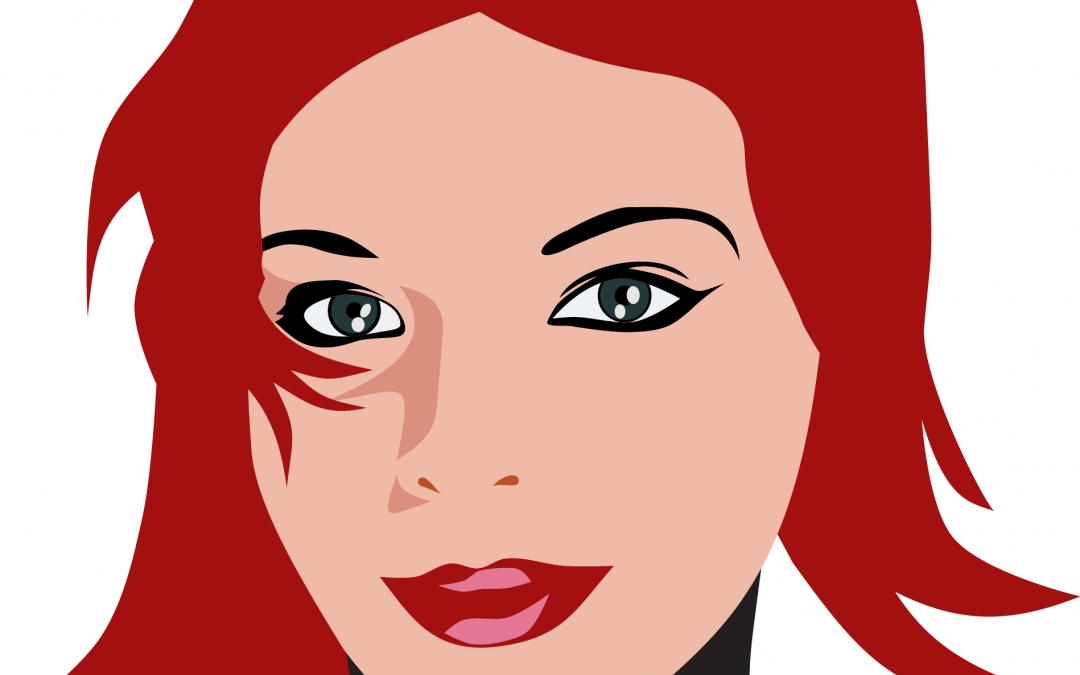
Dec 6, 2022 | Front Page, Infosec, Portland Confidential
by Rose C.
Writing this at a time when sadly, I will not be able to stay in Portland, my chosen city, for very much longer. I won’t bore you with the details. My apartment has ventilation and habitability issues. I thought for a long time that I could mitigate the poor air quality with houseplants, fans, and open windows but it’s no longer practical. Not with winter coming on.
I hope to keep PDX Local going strong, though. I will always be a Portlandian in my heart. One of these days I will get around to putting up formal writers’ guidelines. In the meantime, if you have a story, wherever you live, feel free to get in contact and pitch. Unsolicited submissions are also welcome although we don’t print every story that is sent our way.
Anyway, back to today’s chosen topic.
Lesson #1 – Hackers are never as cool as they think they are. As I once wrote to the leader of my Hackerspace in an email, “Hackers think they are cool. Everyone else thinks we are dangerous criminals.”
Rami Malek notwithstanding. His character on Mr. Robot will always be cool, at least to me.
Lesson #2 – Not all hackers are criminals. Ummm, probably not even most. We do tend to think that laws around media piracy are for other people, and freely share audio, video, game, and text files whenever we can. There is so much corporate censorship already in the world that we often feel justified in going down this road. As for me personally, I don’t steal media or make unauthorized copies. I am extraordinarily law abiding.
Hackers like me, who refrain from breaking the law, are sometimes known as whitehats. I prefer the term “lawful and ethical hacker,” because it has no racist connotations. (Criminal hackers used to be called blackhats.)
This has less to do with the chances of getting caught and more to do with the fact that I am an artist as well as a programmer. I believe that creative work should be compensated, and that creators deserve the opportunity to make a living. When only wealthy trust fund kids have the opportunity to write memoirs or play in bands, we know that something is wrong with our universe.
Lesson #3 – IF YOU CALL YOURSELF A HACKER, YOU WILL GET HACKED. Certain people view the label as an invitation to test out your defenses. It can’t be helped.
It may not be anything bad. Maybe just a little spyware, or a Bitcoin miner hidden unbeknownst to you on your computer. Or it might be more severe. So be careful about using the term lightly. Many hacks can be prevented, but as long as people write new software, there will always be new vulnerabilities.
Back when I ran a web hosting company, I asked my former sysadmin what he thought about the slogan, “Your money back if you get hacked.” He wouldn’t go near it. While he was working part-time for me, he was also a VP managing cybersecurity and automation for a major national bank. You would have to assume he knew what he was talking about.
I don’t practice pentech, as hacking techniques designed to crack and illegally break open other peoples’ systems are known. So if I’m not pirating music and movies, and I also don’t try to break into other people’s systems, why do I call myself a hacker?
Lesson #4 – Hackers hack. It’s what we do. What I mean by hack is simple. We like to build things with electronics. Honestly, I would probably pay good money just to have the opportunity to keep doing this type of work. Collaboration, and with it the ethos of Free and Open Source Software (or FOSS) is also key to our worldview. We have our own language, and our own “in jokes.”
Here’s one you’ve probably seen before. The only other form of creativity that comes even close to being this collaborative without being rigidly hierarchical is music. That is probably part of why enjoy seeing live bands and being part of the Portland music scene so much; unfortunately I can’t carry a tune or play an instrument so I had to learn to code instead.
Still learning, actually. And probably will be for life.
Originally published on December 6, 2022. This post has been modified from its original version.

May 15, 2022 | Front Page, Infosec, Portland Confidential, Queer
Still pretty femme here.
This post first appeared on Medium on January 3, 2017. It has been edited from the original version.
Gender nonconforming while a Scorpio
by Rose C.
I went to a queer support group here in Portland and, for the first time ever, asked the people in the group to call me Jack.
And they did!
And I was blown away. It kind of made my night. I was inwardly beaming. Having trouble paying attention to others’ heart-rending stories, I was so inwardly thrilled to be recognized as Jack.
Me, a large-breasted girl with painted fingernails, longish hair, full lips, and a sweet, heart-shaped face. I was Jack! I had claimed some essence of my masculine self, and people had listened.
Not sure what to do about pronouns and the rest of it. Genderfluid and trans. “They/them” works nicely, for those that bother to ask. I’m not getting tied up in knots about this. I mean, I still carry a purse.
Where this goes next, I have no idea. But here is a bit of backstory.
Last Monday night I decided to try an experiment. There was this young dude (30, great body, worked out all the time) who had expressed an interest in me that was more than purely professional. About a month and a half ago we ended up making out past 2 AM in some downtown bar whose name I don’t even remember. We took an Uber to his place but stopped just short of having sex.
I wanted to think through my current relationship, long distance and already polyamorous in theory, and decide whether I really wanted to open it up to somebody new. I also figured I should get re-tested for STDs, just to be safe.
The answer I came to was emphatically, yes. So last week I sent Young Dude a text to see if he wanted to catch the Warhol exhibit in town. Four hours later, we ended up eating vegan mozzarella at a punk rock dive bar, then singing karaoke (my performance was unimaginably bad), then back to my place. The night was comically ill-timed (the smell of burning rubber alerted us that the tea lights were melting the blinds, even though not directly in contact) and a cold shower almost gave my date hypothermia.
The interesting part of the experience was that even though I knew I might be getting laid that night, I made no special effort to femme it up. Legs remained unshaven. I wore out the same bulky black hoodie that I wear everywhere. This was intentional (even though I did clean up the apartment some, with the thought that somebody might be coming back).
I decided, just that once, to act like a man — which is to say, just be me.
No special outfit, very little makeup.
This is me at 40, folks. I wanted to not apologize for it or cover it up. I wanted to see what would happen. No regrets.
Face it: my body will probably never look the same in lingerie as it did five years ago. I lost a lot of weight after my divorce — got to experience about seven years of having pretty much my ideal body. But then one day, metabolism and time catches up with you. You start to wonder, what exactly does the future hold in store for average looking women in their forties and fifties who don’t have kids?
I am viewing this unavoidable process of aging as an excuse to explore my more masculine side. Which is weird, because I really love my body. I can’t imagine having chest surgery. I could fantasize about a deeper voice, chest hair, all the other effects of “T”. (And yes, I’ve done the research about transitioning in midlife.)
I have no idea how other people experience gender. I just know that I almost never feel like a girl. Even when I did femme it up, it felt like a costume, or a video game avatar. A really fun and sexy costume, but something contrived and separate from the essence of who I was.
I know that I’m also a very nurturing and empathic person, and that those traits put me in the bucket of “feminine.”
But then… this is also me. Leader. Builder of things. Entrepreneur. Somebody who prefers to call shit like it is and isn’t afraid of conflict. Somebody with an unflagging code of loyalty to my peeps, even when they don’t return the same. Somebody whose idea of a perfect evening is just having two beers with a buddy. Really. That’s it.
Interests: comics, rock and roll music, computers, science fiction.
I think about why I have so many more guy friends than female friends, and it’s easy to just chalk it up to women being busy with children and partners, or women’s internalized jealousy and mistrust of other women.
But sometimes I wonder. Maybe something is clicking for me on a deeper level. I’ve never been a tomboy, never been super butch although I did shave my head in my early 20s. I’ve only ever been with two women in my life.
I feel dorky for embarking on this “voyage of self discovery” at the cusp of middle age. But I also feel like to try and fit a mold I outgrew sometime in the last few years might be literally dangerous to my health.
I had plenty of years to play the “cute girlfriend.” Am I now going to be the “less cute girlfriend?”
I guess for me the essence of masculinity is being perceived for my talent, strength, and ability rather than for how I look or my relationship to others. It has very little to do with having a penis or chest hair. And yet, projecting this self while outwardly feminine can be threatening to some.
I have thought about this shit for years, but never expressed it publicly before. I don’t know where it will lead. At this point in my life I am used to feeling like an outcast, even while deftly maneuvering professional and social situations and keeping casual acquaintances at arm’s length. Adapting a less traditional gender presentation might change that. It might make me, finally, a bit less closeted in my multifaceted “otherness.”
And honestly, that might be a change I am looking for.
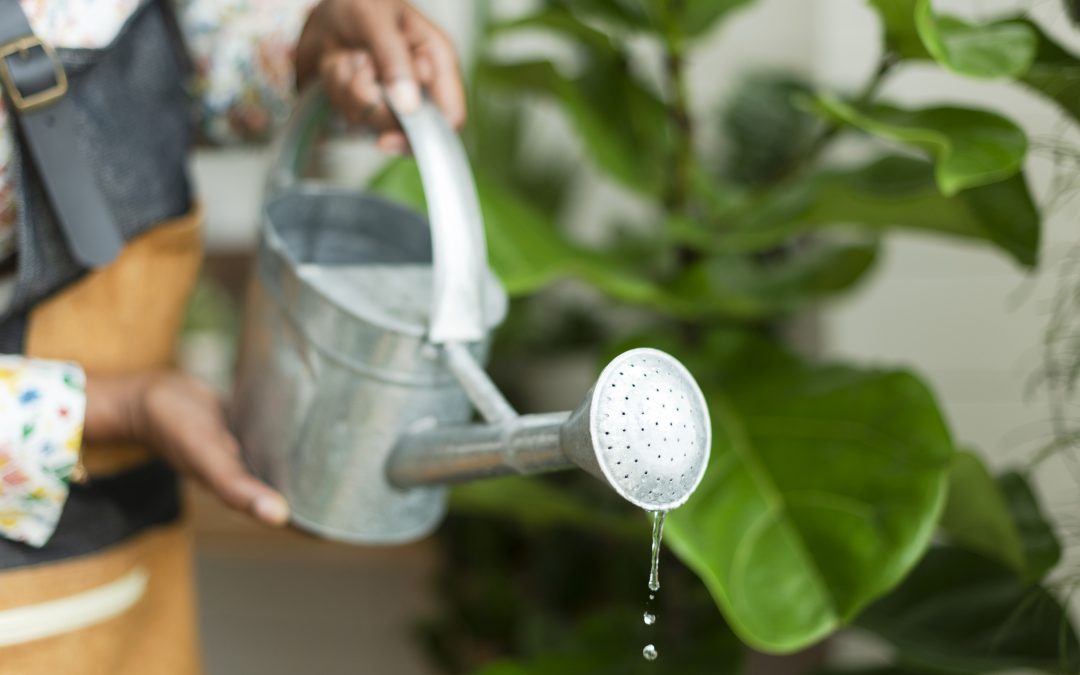
Apr 5, 2022 | Environment, Front Page, Organic, Sustainable, Vegan
by Beverly Nelson
Growing a garden can be a great way to spend more time outside, learn valuable new skills, and even reduce your family’s grocery budget. Furthermore, you can also help feed those in need in your community simply by growing fresh produce in your backyard.
Remember that whenever possible, it’s better to shop locally. Buying from small and local businesses helps support the entire community and promotes a sense of shared responsibility. Look for who is helping to get the word out in your area, like PDX Local in Portland OR.
Steps to Starting Your Garden
If you’ve never planted a garden before, you might be confused about where to begin. Whether or not you’re a green thumb, getting acquainted with the soil and the various types of produce has huge payoffs. But first consider these ideas as you set out on your gardening venture.
- Building raised garden beds will help you protect your crops from tunneling pests.
- To plant, tend, and harvest your vegetables, you’ll need some durable gardening tools.
- Test your soil to see what level of acidity and nutrients you’re dealing with, then address high or low levels with appropriate treatment, such as adding nitrogen.
- Once you have all of the tools and supplies you need, you’re ready to plant. Follow the helpful tips below on growing vegetables, herbs, trees and more!
- Tend to your garden each day to ensure that your plants are healthy and promptly harvest fresh vegetables.
- If you’re stumped on where to begin, consider hiring help from a local gardener or landscaper. You can survey backyard landscaping companies to help pave the way for your garden.
Preserving Your Delicious Harvest
It’s possible to plant and grow just enough in your garden for you and your family to consume, plus a little for friends, too. But if you end up with more fruits and vegetables than you know what to do with, these methods will allow you to preserve them so that they don’t spoil.
- Canning your surplus vegetables is a great way to keep them fresh for months.
- Incorporate your canned vegetables into one of these healthy recipes!
- Stock your freezer with frozen fruits and vegetables for soups and other dishes.
- Whip up homemade jam to make your breakfasts taste a little sweeter.
Serving People in Need
Food insecurity exists in every community. In addition to selling your produce at the local farmers market for a discount of what the grocery store charges, here’s how to ensure that your extra produce goes to the people who need it most.
- Offer to drop off your extra produce and some non-perishables at one of Portland’s community food pantries.
- Encouraging your children to help you distribute food to vulnerable people can teach them about the root causes of poverty and other forms of injustice.
- Host a food swap to exchange produce and canned goods with your neighbors!
- Consider working with others in your neighborhood to establish a community garden where people can tend their own plots and share fresh produce.
Gardening on a Small Scale
Perhaps all this sounds great but you’re looking around at your small apartment and thinking there’s no way you can maintain a garden in such a small space. Think again! Granted, you obviously can’t feed an army in a small space, but there are plenty of people who maintain successful gardens from apartments.
When you begin your garden, you may have to go through some trial and error as you learn the ropes. But when you’re cooking up delicious dinners with your veggies and helping your neighbors put food on the table, you’ll be happy that you took on this rewarding project!
PDX Local is an all-volunteer organization dedicated to helping get the word out about important community resources and small business. Call 971.412.2493.
Photo via Rawpixel
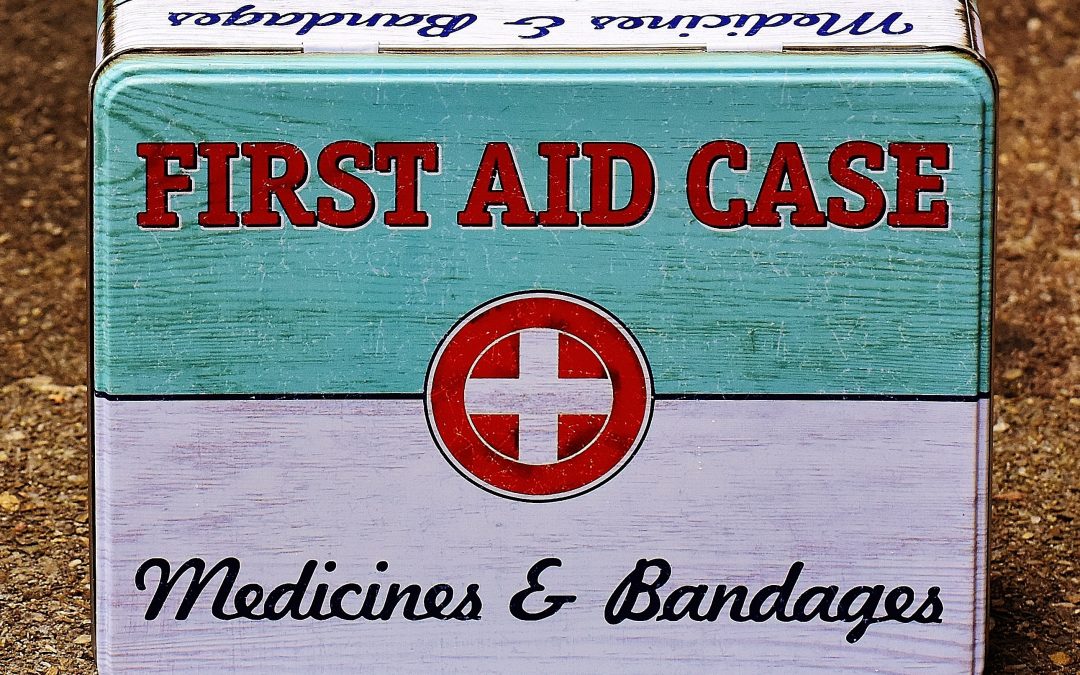
May 14, 2020 | Front Page, Health
First Aid for Attempted Suicide
Article by Sarah Gehrke, MSN, RN. Reprinted with permission from https://pacificmedicalacls.com.
Suicide touches all ages and incomes; all racial, ethnic, and religious groups; and in all parts of the country. It is a leading cause of death in the US.
As self-inflicted injuries increase so does the need to prepare for encountering someone who has attempted suicide. As a first-aid provider, you have a vital role in addressing immediate medical needs. You can also provide clarity and support to the victim and other people at the scene.
In 2017, guns were the most common method of death by suicide, accounting for a little more than half of all suicide deaths. The next most common methods were suffocation at 27.72 percent, and poisoning at 13.89 percent.
The following first-aid recommendations are for each of the most common methods of attempted suicide. Each case is unique, and it is essential to tailor your care and support to that person’s needs.
Above all ensure the safety of everyone present and address any serious medical needs first.

© Staff Sgt. Natasha Stannard / Joint Base Langley-Eustis / CC-BY-SA-3.0
First Aid for Gunshot Wound
A self-inflicted gunshot wound (SIGW)—or any gunshot wound—to the head is correlated with severe disability and a high mortality rate. There is a greater chance of death caused by SIGWs compared to victims injured by gunshot wounds that are delivered in an assault or by accident.
- Head trauma from a gunshot wound is fatal in about 90 percent of cases, with many victims dying prior to arriving at the hospital.
- About 50 percent of the victims that survive the initial trauma die in the emergency department.
- Head trauma from a gunshot wound is the cause of approximately 35 percent of deaths attributed to traumatic brain injury.
Although the head is the most commonly injured body region during a suicide attempt, the following is a general guideline for how to approach a gunshot wound on any area of the body.
- Ensure your safety. Ensure the scene is safe and immediately call or have someone else call 9-1-1 or emergency medical services.
- Locate the source of the bleeding. Attempt to open or remove the clothing over the wound so you can see it—this will allow you to see injuries that may have been covered or hidden.
- Stop the bleeding. Pressure to stop the bleeding is the most critical intervention. If the victim has blood that is coming out of a hole, put steady pressure on it with both hands by pushing down as hard as you can.
- Use a dressing (towels, shirts, gauze, etc.). Dressings will help seal the wound and aid in clotting.
- Elevate the extremity. If the gunshot wound is above the waist do not elevate the legs to treat for shock (unless the injury is in the arm). Gunshot wounds to the chest and abdomen will bleed more rapidly if the legs are elevated, thus making it more difficult for the individual to breathe.
- If you can, use a tourniquet. Tourniquets will only work on arm and leg injuries. Using them correctly takes practice, and they should only be used if the bleeding cannot be stopped when direct pressure and elevation are applied immediately and simultaneously or if there is a reason why direct pressure cannot be maintained.
- Gunshot wounds to the chest may be sealed with a type of plastic to keep air from being sucked into the wound—this can help prevent a collapsed lung. Remove the seal if shortness of breath worsens after sealing the wound.
- Chest compressions in a cardiac arrest caused by hemorrhagic shock from severe blood loss may worsen the situation.
First Aid for Hanging or Suffocation
Self-administered and assisted suicides by asphyxiation—the process of being deprived of oxygen resulting in unconsciousness or death—can be done by several methods. The use of a plastic bag, or suicide bag, is often in conjunction with a flow of an inert gas like nitrogen or helium.
Suicides using a plastic bag with helium were first recorded in the 90s. Since the 2000s, guides on how to use this method have spread on the internet, in print, and on video; and the frequency of suicides by this technique has increased.
Asphyxiation is also present in hanging and strangling. Both hanging and strangling can obstruct blood flow to and from the brain as well as block air flow to and from the lungs.
How to Recognize Suffocation
- A constricting article is around the neck
- Marks around the victim’s neck where a constriction was removed
- Impaired consciousness or unconscious
- Grey-blue skin (cyanosis)
- Uneven breathing
- Prominent veins and congestion of the face
- Petechiae – tiny red spots on the face or the whites of the eyes
What to Do in the Case of Suffocation
- Make sure the scene is safe, and immediately remove any constriction from around the victim’s neck; support the body if it is still hanging.
- Call or have someone else call 9-1-1 or emergency services.
- Lay the victim on the floor. In the case of spinal injury, don’t move the victim unnecessarily.
- Check for breathing and pulse; If not breathing begin CPR.
- If breathing, place in the recovery position and monitor until emergency responders arrive.
- Don’t interfere with or destroy any material, such as a knotted rope, that police may need as evidence.
First Aid for Overdose or Poisoning
Poisoning is due to swallowing, inhaling, touching, or injecting various chemicals, drugs, gases, or venoms. Both suicide and unintentional drug overdoses kill adults at twice the rate today as they did two decades ago, and opioids are a key contributor to this rise. The following focuses on the use of drugs as a means of attempting suicide.
When a drug overdose is suspected, you may not know what drug the person was taking. Often, an overdose victim will either be unconscious or not fully conscious of their surroundings. Because of this, it is imperative to recognize the general signs of a drug overdose and what to do for first aid in the majority of situations.
How to Recognize an Overdose
- Unusual sleepiness or unresponsiveness
- Confusion, disorientation, or hallucination
- Slow, shallow, irregular, or absent breathing
- Bradycardia (slow heartbeat) or hypotension (low blood pressure)
- Cold and clammy skin
- Constricted pupils (small or pinpoint pupils)
- Cyanotic (nails and lips are blue)
- Mood changes, including aggression, agitation, anxiety, or depression
- Abdominal pain or vomiting
- Loss of coordination or motor control
Do’s for Drug Overdoses
- Make sure the scene is safe, and check alertness. Comfort them if they are awake. If they are unconscious, turn them on their side to prevent aspiration (choking on their vomit).
- Call 9-1-1 or emergency medical services. Call, or have someone else call, even if the person seems not to be experiencing overdose symptoms; never wait to see if the overdose will wear off. Some effects of an overdose don’t present themselves right away.
- Check for breathing and pulse; If not breathing begin CPR.
- Remove unnecessary clothing if the situation allows. Some drugs cause the patient to quickly overheat.
- Find details to aid with treatment. Knowing what drug was taken, how much, when, and by what method is important. If the victim is not awake, look for containers, needles, syringes, and other items.
Don’ts for Drug Overdoses
- Don’t put the person in the shower. Even if the victim seems okay, a large temperature change could put them in shock.
- Don’t let the person sleep. Someone who overdosed may pass out, and you will not be able to stop them; however, trying to keep them awake makes it easier to monitor their condition.
- Don’t attempt to make them throw up if they took the drugs orally. This can increase the chance of aspiration.
- Don’t wait for the drug to wear off. Call for emergency medical services immediately.
- Don’t try to feed the victim. Some foods can have adverse effects.
- Don’t leave the victim alone. Stay with them, monitor their condition, and provide help as needed.
- Don’t try to reason with or restrain a violent person or put yourself in an unsafe position.
First Aid for Known Opioid Overdose
Examples of opioids include morphine, codeine, oxycodone, oxycodone with acetaminophen, and hydrocodone with acetaminophen. Because opioids affect the part of the brain that controls breathing, too high of opioid levels in the blood can slow breathing down to dangerous levels, which could cause death.
For victims with a suspected or known opioid overdose who have a definite pulse but no normal breathing or only gasping (respiratory arrest) in addition to providing standard care, it is reasonable for trained rescuers—this includes first aid providers, non-healthcare providers, or BLS providers—to administer Narcan® (naloxone) intramuscularly or intranasally to victims with an opioid-associated respiratory emergency.
Victims with no definite pulse may be in cardiac arrest or they may have an undetected slow or weak pulse. These cases should be managed as a cardiac arrest victim.
Standard resuscitation should take priority over the administration of naloxone, with a focus on high-quality CPR. It may be reasonable to administer naloxone—especially when an opioid overdose is suspected—based on the possibility that the victim is in respiratory arrest, not cardiac.
Opioid-Associated Life-Threatening Emergency (Adult) Algorithm
- Assess and activate. Check for unresponsiveness and call for nearby help. Send someone to call 9-1-1 and get AED and naloxone. Observe for breathing versus no breathing or only gasping.
- Begin CPR. If the victim is unresponsive with no breathing or only gasping, begin CPR (CPR technique based on the rescuer’s level of training). If alone, perform CPR for about 2 minutes before leaving to phone 9-1-1 and get naloxone and an AED.
- Administer naloxone. Give naloxone as soon as it is available. 2 mg intranasal or 0.4 mg intramuscular. May repeat after 4 minutes.
- Does the person respond? If yes, stimulate and reassess. Continue to check responsiveness and breathing until advanced help arrives. If the person stops responding, begin CPR and repeat naloxone. If no response, continue CPR and use an AED as soon as it is available. Continue until the person responds or until advanced help arrives.
First Aid for Self-Harm or Self-Cutting
Because self-harm, also known as self-injury or self-cutting, involves physical injury, it can seem like self-harm and suicide are directly related. For example, it is common to think that cutting one’s wrist may be a suicidal gesture indicating that the person wishes to slit their wrists to die.
Self-injury can indicate a number of different things. Many people who practice self-injury may not intend to kill themselves and may even see self-harm as a way of avoiding suicide. It is crucial to note that with the pattern of self-injury occurring over weeks, months, or years, the person may be at risk for suicide.
Here’s what you should do if you a self-harm situation presents to you:
- Make sure the scene is safe, and assess and activate. Assess the victim’s responsiveness. Call or have someone else call 9-1-1 or emergency services.
- Locate and control the bleed. Arterial blood is bright red and spurts or sprays from the wound. If the blood is darker in color and easier to control, it means that the veins have been cut, and the artery was missed.
- Apply direct, firm pressure. Apply a towel or dressing directly to the wound.
- Elevate. Position the wounded limb in a position where it’s above the victim’s heart.
- Occlude or pinch an artery above the injury. If possible apply pressure to an artery to halt the blood supply to that limb. If the bleeding does not stop after direct pressure, a tourniquet may be needed.
- Assuming the bleeding has stopped, continue to assess the victim—circulation, airway, and breathing. Follow the Basic Life Support (BLS) Algorithm.
If You Know Someone in Crisis:
Call the toll-free National Suicide Prevention Lifeline (NSPL) at 1–800–273–TALK (8255), 24 hours a day, 7 days a week. The service is available to everyone. The deaf and hard of hearing can contact the Lifeline via TTY at 1–800–799–4889. All calls are confidential.
Washington State Crime Victim Service Center Hotline: 888.288.9221
Contact social media outlets directly if you are concerned about a friend’s social media updates or dial 911 in an emergency.
Learn more on the NSPL’s website. The Crisis Text Line is another resource available 24 hours a day, 7 days a week. Text “HOME” to 741741.
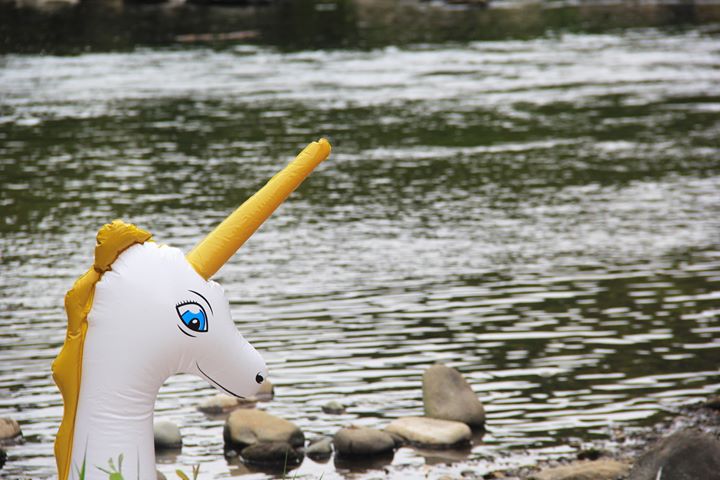
May 8, 2020 | Culture, Front Page, Local Business, Minority Owned Business
Freestyle verse by Sincere God Magnetic
We’re already socially distant. The pandemic is reaction to the systemic distortion of academics. 5G is radioactive pollution while the body succumbs to inner confusion designed and spread by mass media controlled execution. Mistrust is a must in a world built on ashes to ashes, dust to dust. The meek won’t inherit the earth as stock markets crash and cryptocurrency gains its worth. All in all as hysteria rises the unseen government builds firewalls to prevent a scenario that ends in total recall and catastrophic downfall. The love frequency has been corrupted by mental meltdown and deviant delinquency. Stay aware and resilient, maintain your militant stance, we’ve been infiltrated by reptilians. Tomorrow never knows but today the heat signature in the atmosphere grows causing an unprecedented increase in the force of tidal flows. We must dwell and excel together as we have crossed the threshold into the new forever.

